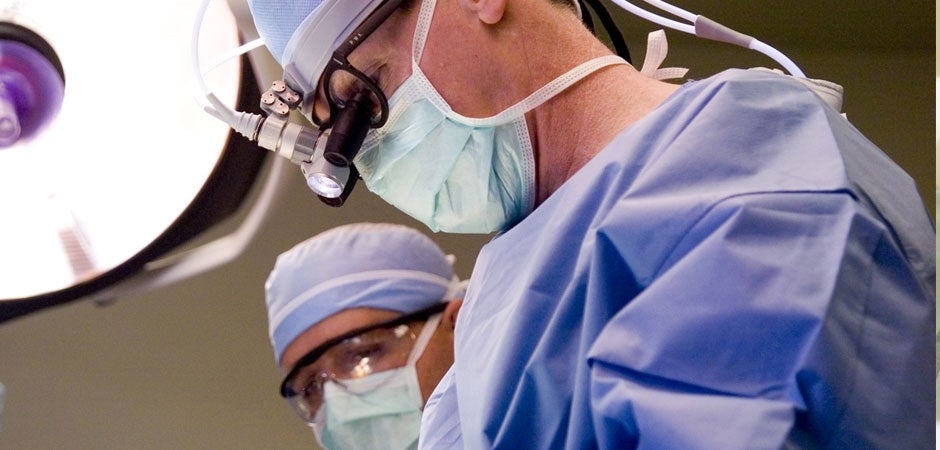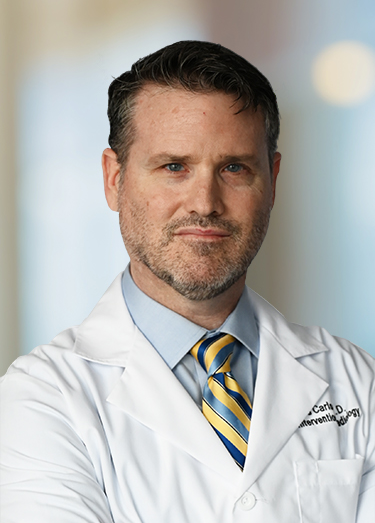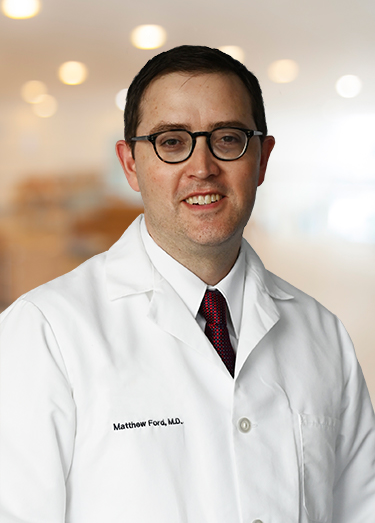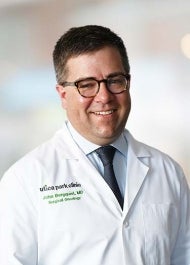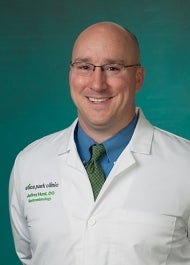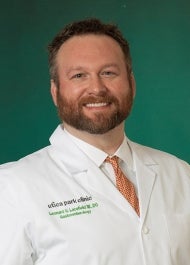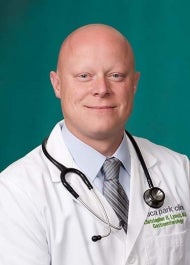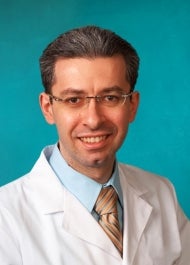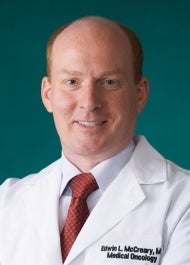OVERVIEW
The Hepato-Pancreato-Biliary surgery program at Hillcrest provides treatments for diseases of the digestive tract including the esophagus, stomach, liver, bile ducts, gallbladder, pancreas, small intestine and peritoneum. Due to the complexity of these diseases, treatment may involve a group of highly-specialized physicians specifically trained in hepatobiliary care, surgical oncology, advanced gastroenterology, medical oncology and radiation oncology. This multi-disciplinary team of nationally recognized physicians works to provide breakthrough treatments for you.
WHAT WE TREAT
The pancreas is an organ in the abdomen, which has both endocrine and exocrine functions. The exocrine portion regulates both the gastrointestinal tract as well as other systems in the body such as glucose levels. The endocrine portion regulates digestion and absorption of food and vitamins in the intestinal tract. Conditions such as acute pancreatitis and chronic pancreatitis can be severe and life threatening, requiring emergent care and advanced treatment options such as endoscopic ultrasound and complex pancreatic surgery.
Other conditions such as pancreas cysts and chronic pancreatitis can lead to disabling symptoms, including an increased risk for pancreas cancer requiring advanced imaging and endoscopy to avoid long-term problems. Pancreas cancers are challenging diseases, which require multi-disciplinary teams specially trained in pancreas cancer in order to cure the disease using chemotherapy, radiation and surgery.
The Hillcrest hepatobiliary team is one of the only experienced robotic Whipple programs in the United States, the only of its kind in Oklahoma and the only comprehensive pancreatitis program in Oklahoma.
Types of pancreas diseases:
- Acute pancreatitis
- Chronic pancreatitis
- Pancreas cysts (i.e., intraductal papillary mucinous neoplasm, mucinous cystic neoplasm, serous cystadenoma, pseudo cysts)
- Pancreas cancer (i.e., pancreatic ductal adenocarcinoma and pancreatic neuroendocrine tumors)
The liver is an organ in the abdomen, which provides filtering, and production of important substances for the body such as protein. Conditions such as hepatitis and fatty liver disease require workups to avoid long-term liver disease and even liver cancer. Other conditions such as liver cysts, hemangioma, focal nodular hyperplasia and adenomas can cause symptoms that limit your ability to function normally and even increase the risk for cancer or bleeding.
Liver cancers require multi-disciplinary teams specially trained in liver cancer in order to not only cure the disease using surgery or ablation devices, but also to ensure the normal function of the liver. The Hillcrest hepatobiliary team is one of the only experienced robotic and laparoscopic liver surgery programs in the United States and the only of its kind in Oklahoma.
Types of liver diseases:
- Acute hepatitis
- Cirrhosis
- Viral hepatitis (i.e., Hepatitis C, Hepatitis A, Hepatitis B)
- Liver cysts
- Liver abscess
- Hepatic adenoma
- Focal nodular hyperplasia
- Hepatic hemangioma
- Liver metastases (i.e., colon, rectal, breast, neuroendocrine)
- Polycystic liver disease
- Hepatocellular carcinoma
- Cholangiocarcinoma
The bile ducts and gallbladder are comprised of a tube system, which drains digestive juice called bile from the liver to the intestine. The gallbladder is specifically designed as a storage system for bile and frequently develops stones, which can cause pain or other problems such as pancreatitis and jaundice.
Conditions such as bile duct strictures and bile duct or gallbladder cancers are challenging problems, which require multi-disciplinary teams trained in biliary disease to ensure rapid evaluation and treatments such as advanced endoscopy, surgery or chemotherapy, aimed at curing the disease. The Hillcrest hepatobiliary team is one of the only robotic and laparoscopic bile duct programs in the United States and the only of its kind in Oklahoma.
Types of bile ducts and gallbladder diseases:
- Bile duct stricture
- Bile duct injury
- Cholangiocarcinoma / bile duct cancer
- Gallbladder cancer & polyps
- Choledochal cyst & choledochocele
- Ampullary cancer & adenoma
- Sphincter of oddi syndrome
The esophagus is an organ, which starts in the neck and eventually ends in the abdomen, where it allows food to enter the stomach to begin the digestion process. Tumors and cancers of the esophagus and stomach are challenging diseases requiring gastroenterologists specially trained in advanced endoscopy, such as ablation and endoscopic ultrasound, to correctly diagnose the disease. Multi-disciplinary teams trained in esophagus and stomach cancers are required to ensure the correct treatments are used to cure the diseases using chemotherapy, radiation and surgery.
Types of esophageal and stomach cancer diseases:
- Esophageal perforation
- Esophageal tumor (i.e., esophageal leiomyoma, esophageal GIST / gastrointestinal stromal tumor)
- Esophageal cancer (i.e., esophageal adenocarcinoma, esophageal squamous cell carcinoma)
- Stomach cancer (i.e., gastric adenocarcinoma)
- Stomach tumors (i.e., gastric leiomyoma, gastric GIST / gastrointestinal stromal tumor)
The duodenum is the first part of the small intestine where food begins the process of being absorbed after it leaves the stomach. In some conditions, patients can form pre-cancerous growths called polyps, which can cause bleeding and blockages. Advanced endoscopy techniques are required to evaluate and remove early polyps and identify those which require surgery to remove. For duodenal cancers, hepatobiliary surgeons are required to remove these cancers and some patients will require chemotherapy afterwards to cure the disease.
Types of duodenum polyps and cancer diseases:
- Duodenal cancer & polyps
- Duodenal tumor (i.e., duodenal GIST / gastrointestinal stromal tumor, duodenal neuroendocrine tumor)
- Hereditary polyposis (i.e., familial adenomatous polyposis, Peutz-Jeghers Syndrome)
The peritoneum is the lining of the abdomen, which allows fluid and other substances to circulate. In some patients, a cancer from an organ in the abdomen (i.e., colon, rectum, appendix, stomach or ovary) will spread to the peritoneum, or a cancer can form from the peritoneum (i.e., mesothelioma). Because the peritoneum is difficult to treat with traditional chemotherapy in the bloodstream, special techniques are used to remove the cancer from it and treat it with heated chemotherapy. This can increase the effectiveness of other treatments and improve the quality of life for these patients. These diseases require multi-disciplinary teams trained in the management of peritoneal cancers to determine the appropriate timing of treatments and ensure the best outcome for patients.
Types of peritoneal cancers:
- Peritoneal mesothelioma
- Peritoneal carcinomatosis (i.e., colon, rectum, appendix, ovary, stomach)
- Pseudomyxoma Peritonei
The Utica Park Clinic HPB surgery program is located on the Hillcrest Medical Center campus at 1145 S. Utica Ave., suite 701 in Tulsa. For more information, call 918-582-6544.
MEET THE TEAM
Hepato-Pancreato-Biliary (HPB) Surgery
All Providers
Jay Bergquist, M.D., M.S., M.A.
Hepato-Pancreato-Biliary (HPB) Surgery
Susanna McDaniel, DNP, APRN-CNP
Hepato-Pancreato-Biliary (HPB) Surgery
MaryKat Nelson, PA-C
Hepato-Pancreato-Biliary (HPB) Surgery
Jenna Specht, PA-C
Hepato-Pancreato-Biliary (HPB) Surgery
Suma Thomas, APRN-CNP
Hepato-Pancreato-Biliary (HPB) Surgery
Andrea Wall, APRN-CNP
Hepato-Pancreato-Biliary (HPB) Surgery
Gastroenterology
All Providers
Jeffrey Hunt, D.O.
Gastroenterology
Richard Jesudass, M.D.
Gastroenterology
Leonard Lacefield, D.O.
Gastroenterology
Christopher Lynch, M.D.
Gastroenterology
Amjad Mreyoud, M.D.
Gastroenterology
Harvey A. Tatum, M.D.
Gastroenterology
Kishore Vipperla, M.D.
Gastroenterology
Sarah Jameson, APRN-CNP
Gastroenterology
Valerie Mitchell, APRN-CNP
Gastroenterology
Rose Ramirez, PA-C
Gastroenterology
Erin Williamson, APRN-CNP
Gastroenterology
Medical Oncology
All Providers
Laura Kyle Brett, M.D.
Hematology, Medical Oncology
Firas Jafri, M.D.
Hematology, Medical Oncology
Edwin McCreary, M.D.
Hematology, Medical Oncology
Amara Nandikolla, M.D.
Hematology, Medical Oncology
Jennifer O'Stasik, M.D.
Hematology, Medical Oncology
Jehanzeb Riaz, M.D.
Hematology, Medical Oncology
Leslie K. Walker, M.D.
Hematology, Medical Oncology
Aimee Kehres, APRN-CNS
Hematology, Medical Oncology
Maya Kinmon, APRN-CNP
Hematology, Medical Oncology
Regina Mills, APRN-CNP
Hematology, Medical Oncology
